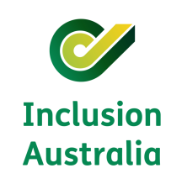Year 12 and senior years – the Australian Education System
School education is similar across all of Australia with only minor variations between states and territories. School education (primary and secondary) is compulsory between the ages of six and sixteen (Year 1 to Year 9 or 10). Senior secondary school runs for two years, Years 11 and 12 (Australian Government, 2019). Senior years can include a range of activities including school-based vocational education and training, university entrance studies, school-based apprenticeships and traineeships and other programs of study.
The problem: low educational attainment for people with intellectual disability
In Australia, people with disability have significantly lower rates of education attainment than people without disability. Recent Year 12 completion rates show that approximately 1 in 3 (32%) people with disability aged 20 and over, and 1 in 4 (25%) with severe or profound disability have completed Year 12 or equivalent (Australian Institute of Health and Welfare, 2017, 2019a). This was much lower than people without disability who have a 62% completion rate of year 12. Unfortunately, there is little available data about the completion rates of students with intellectual disability in Australia in both mainstream and in special schools.
Educational attainment has a significant and ongoing impact on workforce participation. In all OECD countries in 2013, individuals with high educational qualifications had both the highest employment rates and the lowest unemployment rates when compared with individuals with lower educational qualifications (Australian Human Rights Commission, 2016).
Those who have completed Year 12 are more likely to continue with further education or training and have a more successful transition into the workforce (ABS, 2011 cited by Australian Institute of Health and Welfare, 2019b).
Low education achievement is associated with lower work participation and unemployment, a high risk of long-term socioeconomic marginalization, and mental and physical health issues. For those with disability, school-non-completers are also far more likely to receive a disability pension or depend on various public benefits early in life (Myhr et al., 2018).
Those with intellectual disability have particularly high rates of unemployment when compared with other disability groups (Australian Human Rights Commission, 2016; Australian Institute of Health and Welfare, 2019a).
The solution: secondary education completion as a predictor of employment
While the evidence aligning secondary education completion and employment for people with intellectual disability is limited, multiple research studies identify secondary school completion as a predictor of post-secondary open employment for people with disability (LoBlanco & Kleinert, 2013, Papay & Bambara, 2011, Shandra & Hogan, 2008 cited in Southward & Kyzar, 2017). One suggests that students with intellectual disability who successfully completed high school were 4.07 times more likely to secure open employment than those students who did not (LoBlanco & Kleinert, 2013 cited in Southward & Kyzar, 2017). It should be noted, however, that the research studies in this area compare results of many different types of senior secondary school programs (not solely university entrance studies) and also point to a range of additional factors associated with later employment.
References
Australian Government (2019) Australian Education System https://www.studyinaustralia.gov.au/english/australian-education/education-system
Australian Human Rights Commission (2016) Willing to Work: National Inquiry into Employment Discrimination Against Older Australians and Australians with Disability, Australian Human Rights Commission, Sydney.
Australian Institute of Health and Welfare (2017) Disability in Australia: changes over time in inclusion and participation in education. Cat. no. DIS 69. Canberra: AIHW.
Australian Institute of Health and Welfare (2019a) People with Disability in Australia, https://www.aihw.gov.au/reports/disability/people-with-disability-in-australia/contents/education-and-skills/educational-attainment#Highest%20level%20of%20education
Australian Institute of Health and Welfare (2019b) Secondary education: school retention and completion, https://www.aihw.gov.au/reports/australias-welfare/secondary-education-school-retention-completion
Myhr, A., Haugan, T., Lillefjell, M. & Halvorsen, T. (2018) Non-completion of secondary education and early disability in Norway: geographic patterns, individual and community risks, BMC Public Health, 18: 682, https://doi.org/10.1186/s12889-018-5551-1
Southward, J. D. & Kyzar, K. (2017) Predictors of Competitive Employment for Students with Intellectual and/or Developmental Disabilities, Education and Training in Autism and Developmental Disabilities, 52, 1: 26–37.
The authors would like to acknowledge the usefulness of Crosbie, J.: Murfitt, K.; Hayward, S. & Wilson, E. (2019), NDIS Participant Employment Taskforce. Literature review: Employment and economic participation of people with disability, Burwood, Deakin University, as a review of similar literature that provided initial guidance.


